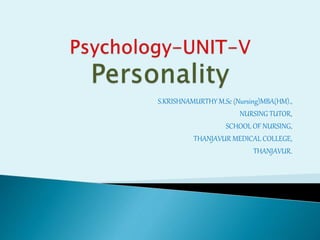
Psychology personality ppt-i year dgnm
- 1. S.KRISHNAMURTHY M.Sc (Nursing)MBA(HM)., NURSING TUTOR, SCHOOL OF NURSING, THANJAVUR MEDICAL COLLEGE, THANJAVUR.
- 2. Personality: 1. Meaning, nature and development, types of personality. 2. Assessment of personality, importance of knowledge of personality for the nurse.
- 3. Latin word – persona -the mask worn by the actors while playing their role in the drama.
- 4. Personality is the total quality of an individual’s behaviour as it is shown in his habits of thinking, in his attitude, interests, his manner of acting and his personal philosophy of life. (or)
- 5. Physical: These are the physical traits or features of an individual namely, height, weight, colour, expression facial physical health. In general, a good personality means an impressive, symmetrical and healthy body. Emotional: A person’s emotions also go into the make up of his personality. Intelligence: An intelligent person will have a forceful personality person with subnormal intelligence is a “dull” person. Behaviour: Behaviour is a reflection of one’s personality. It is partly dependent on our feelings and partly on the expectations of the society. Behaviour may be gentle, kind, affectionate balanced, submissive or aggressive.
- 6. Psychoanalytical Theory Psychosocial Theory Cognitive Theory and Humanistic Theory
- 7. Structure of Personality-Levels of mind
- 13. HUMANISTIC THEORY- MASLOW’S HIERARCHY OF NEEDS
- 14. PERSONALITY BY TYPES BASED ON TEMPERAMENT (HIPPOCRATES) SANGUINE-CHEERFUL (BLOOD) PHLEGMATIC- CALM (MUCUS) CHOLERIC-IRRITABLE (YELLOW BILE) MELANCHOLIC-DEPRESSED (BLACK BILE) WILLIAM SHELDON CLASSIFICATION ACCORDING TO BODY BUILD: ENDOMORPH MESOMORPH ECTOMORPH DR CARL G JUNG CLASSIFICATION ON THE BASIS OF SOCIABILITY EXTROVERTS INTROVERTS. AMBIIVERTS KRETSCHMER’S CLASSIFICATION PYKNIC ATHLETIC ASTHENIC BY TRAITS/ FACTORS
- 20. 1. The physiological factors include the physique of the individual-his size, strength, looks and constitution. 2. The environmental or social factor. 3. Mental or psychological factors including motives, interests attitudes, will and character, intellectual capacities as intelligence, reasoning, attention, perception and imagination. These traits and factors are assessed by psychological tests.
- 21. The following methods are used for evaluation and assessment of personality traits: 1.Observational methods (The interview) 2. Personality inventories (Based on trait theories) 3. Projective techniques (Based on psychoanalytical theory)
- 22. Interview is the most popular method of observation. Appearance, bearing and speech can be noticed. Questions can be asked about attitudes and interests. Interviews are used to evaluate a person’s personality for the purpose of employment and for education as well as for identifying personality traits.
- 23. This is the most common written method of assessing personality. A personality interview is a questionnaire in which the person reports his or her feeling in certain situations. They are very easily checked and scored.
- 24. One of the most commonly used personality tests is the MMPI. This test asks for answers of “True”, “False” or “Cannot” to 566 statements about different personality traits such as attitudes, emotional reactions, physical and psychological symptoms and past experiences.
- 25. Projective tests focus upon what is inside a person rather than what can be seen in a person’s behaviour. These tests try to find out more about a person’s feelings, unconscious desires and inner thoughts. These tests make use of people’s tendencies to make up stories about things they see. When shown an inkblot, for example, people see butterflies, dancing girls, pictures of skeletons, or many other images.
- 26. The Rorschach inkblot test was the first projective test and is still widely used. It was developed by the Swiss psychologist Hermann Rorschach in 1920. Another projective test is the Thematic apperception test (TAT) developed by Henry Murray of Havard University in 1938. The Rorschach test uses ten different kinds of inkblots which must be described by the person taking the test. Projective tests are often used in clinical practice. They are helpful in showing a person’s inner areas of conflict, anxieties or any problems in relationships because the person is free to describe anything.